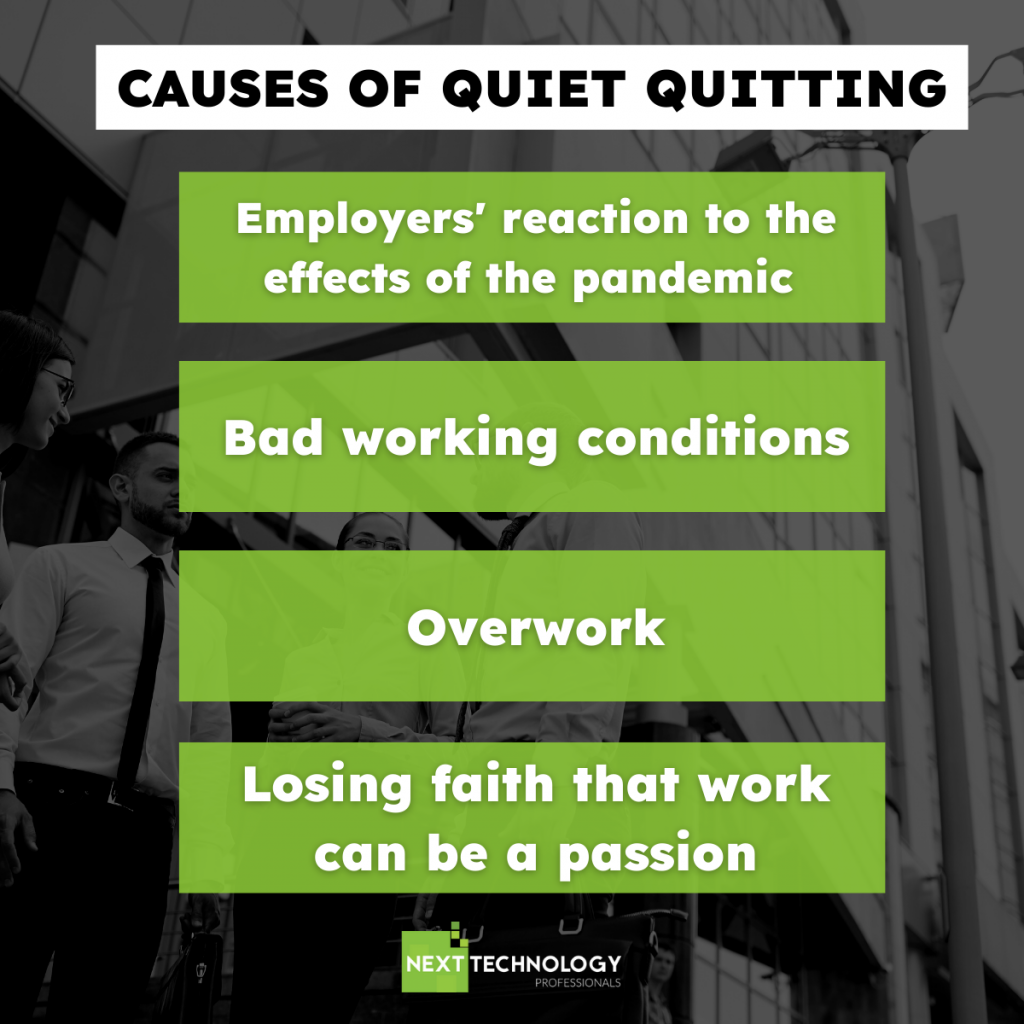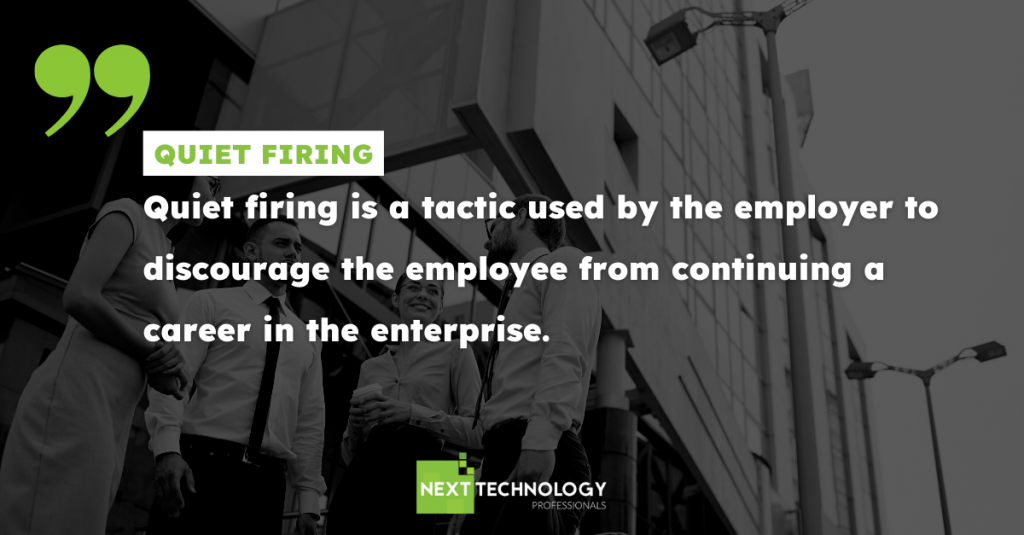We hear about the phenomenon of “quiet quitting” more and more often. According to experts, this is the reaction of employees to excessive workload and high requirements set by employers, with a disproportionately low remuneration for their work. For employees, it is often a way to reduce the level of stress and take care of work-life balance, to which we pay more and more attention after the events related to the outbreak of the COVID-19 pandemic, lockdown and the widespread use of remote mode. Employers, on the other hand, sometimes equate this phenomenon with laziness, lack of commitment to work and giving the absolute minimum, while maintaining full remuneration.
It seems that the post-pandemic period brings a new era in the arena of employer-employee relations. They fight with each other, trying to find the right solution to the equation, in which the amount of effort put in translates into appropriate salary and working conditions. The ongoing struggle raises concerns about the future of the labor market and the maintenance of balance and respect between the two sides.
Even more worryingly, with the advent of ‘quiet quitting‘, the time has come for ‘quiet firing‘, which appears to be an even more immature approach to corporate relations. During sudden changes, have we begun to forget about cooperation whereby employees and employers stand together for mutual benefit, instead of arguing over what is owed more? Are there times of passive-aggressive struggle in companies where the employer and employee are on the opposite side? What consequences could arise from such a rapidly growing wall in this relationship, and how can we protect ourselves from them by restoring balance?
The key seems to be proper, honest communication and noticing and taking care of the needs of each party.
What is “quiet quitting”?

Let’s start from the beginning. What does quiet quitting mean? Quiet quitting can be considered as a silent resignation. It does not, however, mean submitting a notice of termination. The phenomenon is defined as abandoning the cult of work, breaking with the culture of rush and constant undertaking of new challenges, excessive demands and sacrifices for the sake of one’s professional life. It is a kind of rejection of the so-called toil, run in order to achieve further success, outstanding commitment and dedication in the name of work, expectations and needs of the employer. We cease to treat work as a passion, and we derive more and more joy from private life and time for pursuing non-professional interests. A career is seen as a minor sphere of private life and is often only used to earn money.
In practice, such an approach means that employees perform their duties, but only to the extent that it is necessary, without restricting the employee’s abilities. The point is not that the employee is deliberately inferior in the performance of his tasks, but that he refrains from performing additional work that goes beyond basic duties, for which he is often unpaid. Such an employee continues to perform his tasks and even develops professionally, but at the same time sets clear boundaries.
What triggered quiet quitting?
Experts largely see the causes of “quiet quitting” in the changes caused by the coronavirus. In their opinion, it is a by-product of the COVID-19 pandemic, which has resulted in freezes in many sectors of the economy. As a result, millions of employees were dismissed from their positions, and those who remained were often burdened with new duties for which they received no additional remuneration. Workers became increasingly overburdened, frustrated and even burned out. Additionally, the unstable situation negatively affected their sense of security and job satisfaction. More and more employees have begun to wonder why they should give so much when their needs go unnoticed and their efforts underestimated.
The phenomenon of “quiet quitting” has also increased due to the so-called massive resignation in the United States, in which nearly 4 million workers left their current employers each month in 2021. The reasons for this phenomenon were similar – lack of sense, usefulness and satisfaction with the work performed, and the need to pay more attention to work-life balance. As a result of this situation, employees gained greater opportunities in the labor market.

Unfortunately, the phenomenon of quiet quitting is becoming more and more common also in Poland. Noizz.pl summed up the statements of the readers of the portal who shared their opinions and presented the factors influencing the choice of such an approach to work. They identified some underlying causes:
- Employers’ reaction to the effects of the pandemic – e.g. employers’ lack of interest in the conditions in which employees work from home.
- Bad working conditions – e.g. lack of specific options for development, no raises for working a lot more.
- Overwork – exhaustion from continuous, demanding work.
- Losing faith that work can be a passion – lack of willingness to devote your time, energy and commitment to work.
Quiet firing as the answer to quiet quitting

After the phenomenon of quiet quitting, the disturbing trend called “quiet firing” became more and more visible. It is a kind of response to the phenomenon of the loss of employee engagement. While quiet quitting is associated with resignation from ambitious commitment to work, quiet firing is aimed at indirectly inducing an employee to resign from the position taken on his own.
Quiet firing is a tactic used by the employer (usually the leader or manager) to discourage the employee from continuing a career in the enterprise. Various techniques are used in this case, such as deliberate deterioration of the relationship, pointing out minor mistakes, moving the employee away from interesting projects or lack of appreciation.
However, in the case of using such tactics, it is difficult to find a meaningful explanation. In a well-functioning work environment, this should not be the case, and the goal of the company should always be to retain the employee and keep them engaged. So the question arises why there are so many situations in enterprises when, instead of solving problems in accordance with the law and standards, we start to use various types of games, allowing the staff to go into “sleep mode”, and managers using manipulation and mobbing techniques, forcing them to same employees to leave.
Employer versus employee
Quiet quitting and quiet firing generate a lot of employer-employee discussions. While employers are used to the previously applicable work models and there they try to find explanations and justifications for constant changes in their companies, employees shift their professional life to the background, and their priority is work-life balance. In such a situation, do misunderstandings become inevitable? Not necessarily.
According to Matt Spielman from the consulting company Inflection Point Partners, “quiet quitting” is a manifestation of the lack of honest, adult conversations between the company’s representatives. The fact that the phenomenon is becoming so popular is a signal that more and more employees are not engaged in their work. The situation brings losses to both parties – companies are not able to use the potential of employees, and employees spend many hours in unsatisfactory work.
Although the trend of quiet quitting causes anxiety among many entrepreneurs, it is worth noting that it is a starting point for dialogue and an attempt at mutual understanding. Employees want to work less, be able to take care of their health, find time for their passions and be properly rewarded for their work. Quiet quitting becomes popular not only by changing the priorities of employees. The lack of commitment to the development of the company is often the result of overwork, inadequate remuneration, lack of flexibility and the possibility of personal development. The main difference between quiet quitting and quiet firing is intention. Quiet quitting may result from a response to difficulties and problems or unmet needs of employees. Quiet firing, however, discriminates against an employee and is a symptom of the immaturity of the organization and team leaders. And this is definitely a disturbing phenomenon, which we should carefully examine in our companies, because as Adam Grant writes, “quiet quitting does not come from laziness. When people don’t feel that someone cares for them, they eventually stop taking care of the company themselves. If you want an employee to be committed and try harder, start with meaningful work, respect and fair pay.”.
If you want to hire talented IT specialists and take care of their development, contact us. We will be happy to assist you in conducting an efficient recruitment process.




